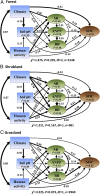Plant diversity enhances productivity and soil carbon storage
- PMID: 29666315
- PMCID: PMC5910804
- DOI: 10.1073/pnas.1700298114
Plant diversity enhances productivity and soil carbon storage
Abstract
Despite evidence from experimental grasslands that plant diversity increases biomass production and soil organic carbon (SOC) storage, it remains unclear whether this is true in natural ecosystems, especially under climatic variations and human disturbances. Based on field observations from 6,098 forest, shrubland, and grassland sites across China and predictions from an integrative model combining multiple theories, we systematically examined the direct effects of climate, soils, and human impacts on SOC storage versus the indirect effects mediated by species richness (SR), aboveground net primary productivity (ANPP), and belowground biomass (BB). We found that favorable climates (high temperature and precipitation) had a consistent negative effect on SOC storage in forests and shrublands, but not in grasslands. Climate favorability, particularly high precipitation, was associated with both higher SR and higher BB, which had consistent positive effects on SOC storage, thus offsetting the direct negative effect of favorable climate on SOC. The indirect effects of climate on SOC storage depended on the relationships of SR with ANPP and BB, which were consistently positive in all biome types. In addition, human disturbance and soil pH had both direct and indirect effects on SOC storage, with the indirect effects mediated by changes in SR, ANPP, and BB. High soil pH had a consistently negative effect on SOC storage. Our findings have important implications for improving global carbon cycling models and ecosystem management: Maintaining high levels of diversity can enhance soil carbon sequestration and help sustain the benefits of plant diversity and productivity.
Keywords: aboveground net primary productivity; belowground biomass; human disturbance; soil carbon storage; species richness.
Conflict of interest statement
The authors declare no conflict of interest.
Figures



References
-
- Jenny H. The Soil Resource: Origin and Behavior. Springer; New York: 1980.
-
- Houghton RA. Balancing the global carbon budget. Annu Rev Earth Planet Sci. 2007;35:313–347.
-
- Crowther TW, et al. Quantifying global soil carbon losses in response to warming. Nature. 2016;540:104–108. - PubMed
-
- Paustian K, et al. Climate-smart soils. Nature. 2016;532:49–57. - PubMed
-
- De Deyn GB, Cornelissen JHC, Bardgett RD. Plant functional traits and soil carbon sequestration in contrasting biomes. Ecol Lett. 2008;11:516–531. - PubMed
Publication types
MeSH terms
Substances
LinkOut - more resources
Full Text Sources
Other Literature Sources
Molecular Biology Databases
Research Materials

